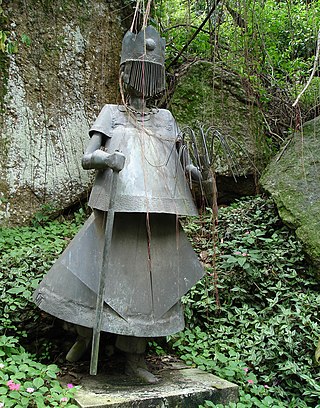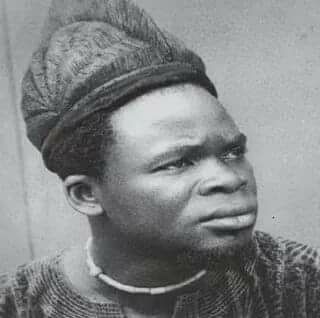Related Research Articles

Vodun is a religion practiced by the Aja, Ewe, and Fon peoples of Benin, Togo, Ghana, and Nigeria.

Ogun or Ogoun is a spirit that appears in several African religions. He attempted to seize the throne after the demise of Obatala, who reigned twice, before and after Oduduwa, but was ousted by Obamakin and sent on an exile – an event that serves as the core of the Olojo Festival. Ogun is a warrior and a powerful spirit of metal work, as well as of rum and rum-making. He is also known as the "god of iron" and is present in Yoruba religion, Haitian Vodou, and West African Vodun.

Shango is an Orisha, a deity in Yoruba religion. Genealogically speaking, Shango is a royal ancestor of the Yoruba as he was the third Alaafin of the Oyo Kingdom prior to his posthumous deification. Shango has numerous manifestations, including Airá, Agodo, Afonja, Lubé, and Obomin. He is known for his powerful double axe (Oṣè). He is considered to be one of the most powerful rulers that Yorubaland has ever produced.

Oshun is an orisha, a spirit, a deity, or a goddess that reflects one of the manifestations of the Yorùbá Supreme Being in the Ifá oral tradition and Yoruba-based religions of West Africa. She is one of the most popular and venerated Orishas. Oshun is an important river deity among the Yorùbá people. She is the goddess of divinity, femininity, fertility, beauty, and love. She is connected to destiny and divination.

Ọya is an Orisha of winds, lightning, and violent storms. As a river deity she is also regarded as a deity of children, able to provide children to her devotees or those who come to her banks at the Niger river.

Orishas are spirits that play a key role in the Yoruba religion of West Africa and several religions of the African diaspora that derive from it, such as Cuban, Dominican and Puerto Rican Santería and Brazilian Candomblé. The preferred spelling varies depending on the language in question: òrìṣà is the spelling in the Yoruba language, orixá in Portuguese, and orisha, oricha, orichá or orixá in Spanish-speaking countries.

The Oyo Empire was a Yoruba empire in West Africa. It was located in present-day eastern Benin and western Nigeria. The empire grew to become the largest Yoruba-speaking state through the organizational and administrative efforts of the Yoruba people, trade, as well as the military use of cavalry. The Oyo Empire was one of the most politically important states in Western Africa from the mid-17th to the late 18th century, and held sway not only over most of the other kingdoms in Yorubaland, but also over nearby African states, notably the Fon Kingdom of Dahomey in the modern Republic of Benin on its west.

Babalú-Aye, Oluaye, Ṣọpọna, Ayé in Trinidad Orisha, or Obaluaiye, is one of the orishas or manifestations of the supreme creator god Olodumare in the Yoruba religion of West Africa. Babalú-Aye is the spirit of the Earth and strongly associated with infectious disease, and healing.
Aganju is an Orisha. He is syncretized with Saint Christopher in the Cuban religion known as Santería.

Durodola Durosomo Duroorike Timothy Adisa Ladipo, more commonly known as Duro Ladipo, was one of the best known and critically acclaimed Yoruba dramatists who emerged from postcolonial Africa. Writing solely in the Yoruba language, he captivated the symbolic spirit of Yoruba mythologies in his plays, which were later adapted to other media such as photography, television and cinema. His most famous play, Ọba kò so, a dramatization of the traditional Yoruba story of how Ṣango became the Orisha of Thunder, received international acclaim at the first Commonwealth Arts Festival in 1965 and on a Europe an tour, where a Berlin critic, Ulli Beier, compared Ladipọ to Karajan. Ladipo usually acted in his own plays.
Ọ̀rànmíyàn, also known as Ọ̀rányàn, was a legendary Yoruba king from the kingdom of Ilé-Ifẹ̀, and the founder of the Oyo empire. Although he was the youngest of the descendants of Oduduwa, he became the prime heir of Oduduwa upon his return to claim his grandfather's throne.

The Legends of Africa reflect a wide-ranging series of kings, queens, chiefs and other leaders from across the African continent including Mali, Benin, Ghana, Nigeria, Congo, Ethiopia, Eritrea and South Africa.
Ọba kò so is a play by Duro Ladipo depicting the mystical and ambivalent personality known as Shango of Yoruba mythology.

The documented history begins when Oranyan came to rule the Oyo Empire, which became dominant in the early 17th century. The older traditions of the formerly dominant Ile-Ife kingdom are largely oral.

The Yoruba of West Africa are responsible for a distinct artistic tradition in Africa, a tradition that remains vital and influential today.

Christianity is the largest religion in Benin, with substantial populations of Muslims and adherents of traditional faiths. According to the most recent 2020 estimate, the population of Benin is 52.2% Christian, 24.6% Muslim, 17.9 Animist and 5.3% follows other faiths or has no religion.
An Oba's crown represents the highest level of authority vested in Yoruba rulers. Referred to as an Adé, the bead-embroidered crown is the foremost attribute of the ruler and the greatest mark of honour and sanction of divine authority. An Oba's crown may also be referred to as an Adé ńlá, literally: Big Crown. Ade in Yorubaland are elaborate conical head gears that feature a heavily beaded veil and fringes that shields or obscure the face.

Vodun art is associated with the West African Vodun religion of Nigeria, Benin, Togo and Ghana. The term is sometimes used more generally for art associated with related religions of West and Central Africa and of the African diaspora in Brazil, the Caribbean and the United States. Art forms include bocio, carved wooden statues that represent supernatural beings and may be activated through various ritual steps, and Asen, metal objects that attract spirits of the dead or other spirits and give them a temporary resting place. Vodun is assimilative, and has absorbed concepts and images from other parts of Africa, India, Europe and the Americas. Chromolithographs representing Indian deities have become identified with traditional Vodun deities and used as the basis for murals in Vodun temples. The Ouidah '92 festival, held in Benin in 1993, celebrated the removal of restrictions on Vodun in that country and began a revival of Vodun art.
References
- ↑ National Geographic Society (U.S.) (1995). National Geographic. National Geographic. National Geographic Society. p. 113. Retrieved 12 August 2018.
What really propelled her, the people said, was the power of a voodoo divinity. Perhaps it was Hevioso, the god of thunder and lightning, or Mamy Wata, the goddess of wealth.
- 1 2 3 4 5 Havelka, Ondřej (2021). "Syncretism of Catholic Christianity and West African Vodun from a Theological-Ethical Perspective". Studia Theologica. 23 (3): 149–174 – via Web of Science Core Collection (Arts & Humanities Citation Index), Scopus.
- 1 2 Adeoye, C. L. (1985). Ìgbàgbọ́ àti Ẹ̀sìn Yorùbá. Ibadan: Evans Bros. pp. 285–302.
- ↑ Asante, Molefi Kete; Nwadoria, Emeka (2007). Spear Masters: An Introduction to African Religion. Lanham: University Press of America. pp. 107–109.
- ↑ Falen, Douglas J. (2018). African Science: Witchcraft, Vodun, and Healing in Southern Benin. Madison, Wisconsin: University of Wisconsin Press. pp. 25–28.
